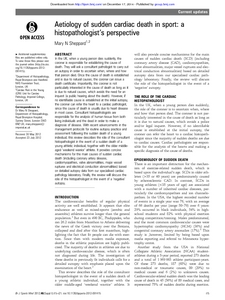Sheppard, MN
(2012)
Aetiology of sudden cardiac death in sport: a histopathologist's perspective.
British Journal of Sports Medicine, 46 Suppl 1.
i15-i21.
ISSN 0306-3674
https://doi.org/10.1136/bjsports-2012-091415
SGUL Authors: Sheppard, Mary Noelle
![[img]](https://openaccess.sgul.ac.uk/107244/1.hassmallThumbnailVersion/Aetiology_sudden_cardiac_death.pdf)  Preview |
|
["document_typename_application/pdf; charset=binary" not defined]
Published Version
Download (495kB)
| Preview
|
Abstract
In the UK, when a young person dies suddenly, the coroner is responsible for establishing the cause of death. They will ask a consultant pathologist to carry out an autopsy in order to ascertain when, where and how that person died. Once the cause of death is established and is due to natural causes, the coroner can issue a death certificate. Importantly, the coroner is not particularly interested in the cause of death as long as it is due to natural causes, which avoids the need for an inquest (a public hearing about the death). However, if no identifiable cause is established at the initial autopsy, the coroner can refer the heart to a cardiac pathologist, since the cause of death is usually due to heart disease in most cases. Consultant histopathologists are responsible for the analysis of human tissue from both living individuals and the dead in order to make a diagnosis of disease. With recent advancements in the management protocols for routine autopsy practice and assessment following the sudden death of a young individual, this review describes the role of the consultant histopathologist in the event of a sudden death of a young athletic individual, together with the older middle-aged 'weekend warrior' athlete. It provides concise mechanisms for the main causes of sudden cardiac death (including coronary artery disease, cardiomyopathies, valve abnormalities, major vessel ruptures and electrical conduction abnormalities) based on detailed autopsy data from our specialised cardiac pathology laboratory. Finally, the review will discuss the role of the histopathologist in the event of a 'negative' autopsy.
| Item Type: |
Article
|
| Additional Information: |
Published by the BMJ Publishing Group Limited. This is an open-access article distributed under the terms of the Creative Commons Attribution Non-commercial License, which permits use, distribution, and reproduction in any medium, provided the original work is properly cited, the use is non commercial and is otherwise in compliance with the license. See: http://creativecommons.org/licenses/by-nc/3.0/ and http://creativecommons.org/licenses/by-nc/3.0/legalcode |
| Keywords: |
Adolescent, Adult, Aged, Anabolic Agents, Arrhythmias, Cardiac, Autopsy, Cardiomyopathies, Cause of Death, Child, Coronary Disease, Coronary Vessel Anomalies, Coroners and Medical Examiners, Death, Sudden, Cardiac, Female, Heart Valves, Humans, Male, Middle Aged, Pathology, Clinical, Physician's Role, Sports, Thoracic Injuries, Young Adult, Science & Technology, Life Sciences & Biomedicine, Sport Sciences, COMMOTIO CORDIS, MYOCARDIAL-INFARCTION, YOUNG, EXPERIENCE, EXERCISE, SPECTRUM, STEROIDS, AUTOPSY, HEART, 09 Engineering, 11 Medical And Health Sciences, 13 Education |
| SGUL Research Institute / Research Centre: |
Academic Structure > Molecular and Clinical Sciences Research Institute (MCS) > Cardiac (INCCCA) |
| Journal or Publication Title: |
British Journal of Sports Medicine |
| ISSN: |
0306-3674 |
| Language: |
eng |
| Dates: |
| Date | Event |
|---|
| November 2012 | Published |
|
| PubMed ID: |
23097474 |
| Web of Science ID: |
WOS:000310452400006 |
 |
Go to PubMed abstract |
| URI: |
https://openaccess.sgul.ac.uk/id/eprint/107244 |
| Publisher's version: |
https://doi.org/10.1136/bjsports-2012-091415 |
Statistics
Item downloaded times since 20 Jan 2015.
Actions (login required)
 |
Edit Item |



